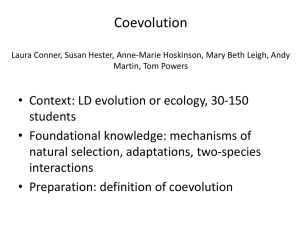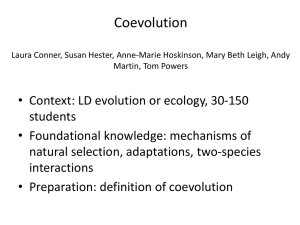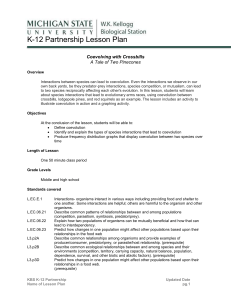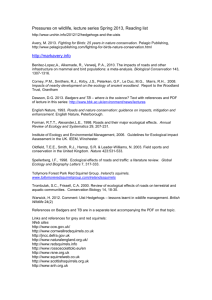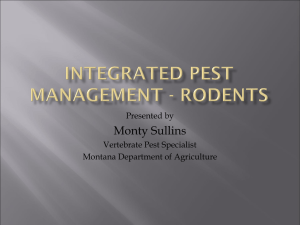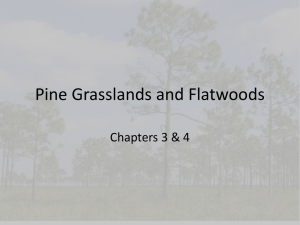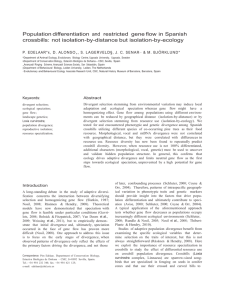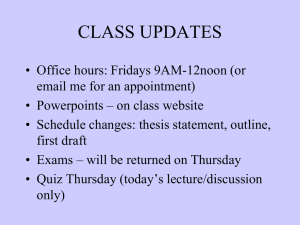Supplemental File S1. Coevolution or not-In-class
advertisement
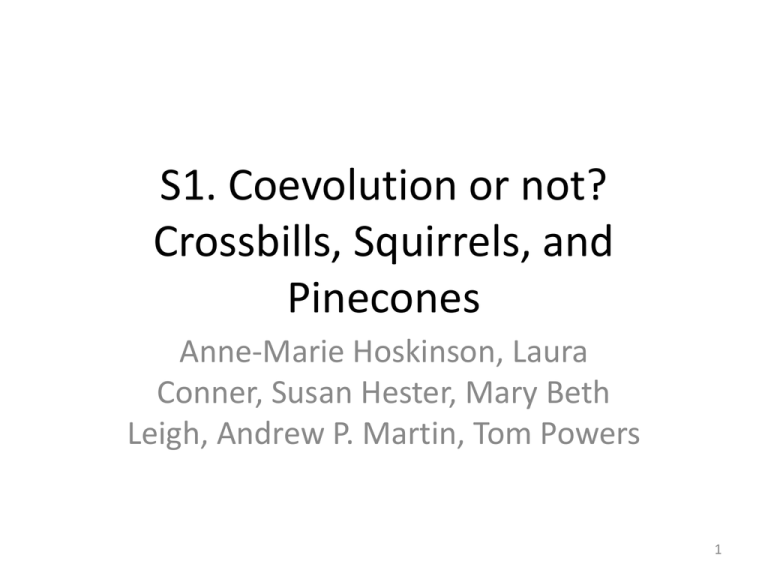
S1. Coevolution or not? Crossbills, Squirrels, and Pinecones Anne-Marie Hoskinson, Laura Conner, Susan Hester, Mary Beth Leigh, Andrew P. Martin, Tom Powers 1 What are the conditions for coevolution? think – pair – share 2 Necessary conditions 1) Two or more interacting species exist in the same place and at the same time 3 Necessary conditions 1) Two or more interacting species exist in the same place and at the same time AND 2) Each species affects the other species’: A. survival B. reproduction (fitness) OR C. some other allele that affects A or B 4 Coevolution requires… BOTH • Geographic overlap of populations • Reciprocal effects on traits 5 How is this coevolution? http://www.arkive.org/cheetah/acinonyx-jubatus/video-08c.html What happens to the gazelles when the cheetahs get faster? The Plot: In the Rocky Mountains, red squirrels and crossbills both eat lodgepole pine seeds. In some locations, squirrels are absent. The species interact when they occur in the same place … but do they have reciprocal effects on one another’s traits? http://idtools.org/id/ dried_botanical/fac tsheet.php?name= Pinus+contorta+va r.+latifolia Red squirrels Crossbill birds Lodgepole pine cones After http://evolution.berkeley.edu/evosite/evo101/IIIF1Casestudyofcoevo.shtml Image credits (L to R): http://commons.wikimedia.org/wiki/File:Tamiasciurus_hudsonicus_CT.jpg http://commons.wikimedia.org/wiki/File:Loxia_curvirostra_NRM2.jpg http://idtools.org/id/dried_botanical/factsheet.php?name=Pinus+contorta+var.+latifolia 7 Lodgepole Pine http://esrd.a lberta.ca/lan dsforests/trees plants/trees/ images/GFXLodgepolePine-01.jpg Figure 1, Benkman et al. 2001. Evolution 55:282-294 http://rockymountainbushcr aft.blogspot.com/2012/12/ro cky-mountain-treeidentification.html Smaller, closed, Larger, open, fewer seeds seedsadapted from Figure 2, Benkman etmore al. 2003. Am. Nat. 162:182-194. 8 Crossbills http://bootstrap-analysis.com/bootimages/crossbills_1.jpg Complete overlap with pine trees shorter, right crossover longer, left crossover Variation in crossover direction and beak depth (length) Watch how crossbills manipulate seeds to feed: http://www.youtube.com/watch?v=1NvU8WG9bg0 9 Red squirrels Pines + crossbills, but no squirrels until 1950 Watch a red squirrel manipulate a cone to feed: http://commons.wikimedia.org/wiki/File:Tamiasciu rus_hudsonicus_CT.jpg http://www.arkive.org/american-redsquirrel/tamiasciurus-hudsonicus/video02a.html 10 What You Will Do • Small groups of 4 • Each group gets one Exhibit (numbered 1 – 3) • Work with: Modeling Evolutionary Relationships System Map your team’s Exhibit each other in order to make a claim, backed by evidence (your Exhibit) about what’s happening • 10 minutes 11 12 Exhibit 1. From Benkman (2001) Evolution 55: 282-294. 13 Exhibit 2. Upper CI* Survival Best fit line 1 = survived 0 = died Lower CI* Bill Depth (mm) From Benkman (2003) Evolution 57: 1176-1181. * CI = 95% confidence interval 14 Value Exhibit 3. 9 8.8 8.6 8.4 8.2 8 7.8 7.6 7.4 7.2 7 Before crossbill predation After crossbill predation Cone Shape (width/length*15) Cone Mass (grams) Pine Cone Trait From Benkman (2003) American Naturalist 162: 182-194. 15 The three species http://kurorisu.blogspot.com /2010/03/america n-redsquirrel.html Squirrel photo Lodgepole pine cone photo http://www.learner.org/jn orth/images/graphics/ab/Beak-Crossbill.jpg http://www.nps.gov/ro mo/naturescience/image s/lodgepole_pine.jpg Crossbill bill photo 16 Based on the data presented, ____________________ are in a coevolutionary relationship. A. B. C. D. E. squirrels and pinecones crossbills and pinecones squirrels and crossbills A and B none of these species What kind of additional evidence would indicate a coevolutionary relationship between squirrel traits and pinecones? Exhibit 4. From Smith 1970. Ecological Monographs 40: 349-371 19 …[Dependent variable] in squirrels will change as a result. Sketching predictive graphs When [independent variable] changes in pine cones… 20
